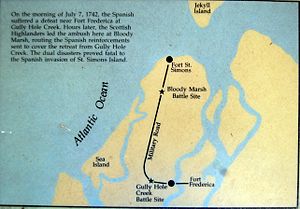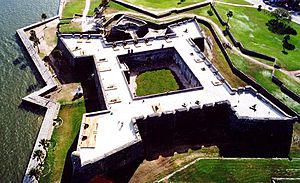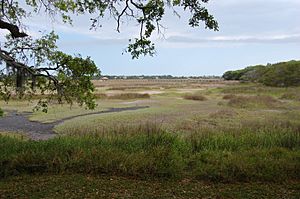Invasion of Georgia (1742) facts for kids
Quick facts for kids Invasion of Georgia (1742) |
|||||||
|---|---|---|---|---|---|---|---|
| Part of War of Jenkins' Ear | |||||||
 |
|||||||
|
|||||||
| Belligerents | |||||||
| Commanders and leaders | |||||||
| Strength | |||||||
| Land: 900 soldiers, militia & Indians sea: 5 vessels |
Land: 1,950 soldiers, marines & militia sea: 36 vessels |
||||||
| Casualties and losses | |||||||
| Light | Over two hundred killed, more captured or wounded | ||||||
The 1742 Invasion of Georgia was a military attack. Spanish forces from Florida tried to take over land in the British colony of Georgia. This area was disputed, meaning both sides claimed it. This invasion was part of a bigger fight called the War of Jenkins' Ear.
Local British forces, led by Governor James Oglethorpe, fought back. They defeated the Spanish in two important battles: the Battle of Bloody Marsh and the Battle of Gully Hole Creek. This forced the Spanish to leave. Later, a peace agreement called the Treaty of Madrid officially recognized Georgia as a British territory.
Contents
Why the Invasion Happened
The colony of Georgia was a problem between Britain and Spain. Spain believed Georgia belonged to its colony of Florida. They thought the British settlers were illegally occupying the land. In 1739, the Convention of Pardo tried to solve this disagreement. However, Spain still refused to give up its claim. When the War of Jenkins' Ear began that same year, Spain started planning to invade Georgia.
The British governor of Georgia, James Oglethorpe, formed a small army. In 1740, he led a British attack on Florida. He hoped to stop a Spanish invasion of Georgia before it started. The British tried to capture St. Augustine, but they had to retreat. After this, the Spanish commander Manuel de Montiano was ready to launch his attack on Georgia. Britain was busy fighting in other parts of the world. This meant no more soldiers or supplies could be sent to defend Georgia.
The Spanish Attack Begins

The Spanish governor, Don Manuel de Montiano, led the invasion force. Some reports say he had between 4,500 and 5,000 men. About 1,900 to 2,000 of these were ground troops. Oglethorpe's forces were much smaller, with fewer than 1,000 men. These included regular soldiers, local fighters, and Native American allies.
Landing on St. Simons Island
The Spanish arrived with 36 ships. On July 5, 1742, they landed nearly 1,900 men near Gascoigne Bluff on St. Simons Island. The small British fort at St. Simons tried to stop them with cannons. But they could not prevent the landing.
Facing a much larger enemy, Oglethorpe decided to leave Fort St. Simons. He ordered his small group of soldiers to damage the fort's cannons and structures. This was done to prevent the Spanish from using the fort fully. The next day, the Spanish took over the fort. They made it their base on the island. Montiano then started gathering information about the British forces.
Battle of Gully Hole Creek
After landing, the Spanish began to explore the area around their fort. They found a road between Fort St. Simons and Fort Frederica. At first, they thought it was just a small farm road. On July 18, about 115 Spanish soldiers, led by Captain Sebastian Sanchez, explored the road.
About one and a half miles from Fort Frederica, Sanchez's group met Oglethorpe's soldiers. These British troops were led by Noble Jones. A fight broke out, which became known as the Battle of Gully Hole Creek. The Spanish were badly defeated. Nearly a third of their soldiers were killed or captured. Oglethorpe's forces chased the retreating Spanish towards Fort St. Simons. Spanish prisoners told them that a larger Spanish force was coming from Fort St. Simons. Oglethorpe left to gather more soldiers.
Battle of Bloody Marsh
The British soldiers who were chasing the Spanish met more Spanish troops. They fought briefly, then fell back. When the British reached a bend in the road, Lieutenants Southerland and Macoy told them to stop. The British soldiers and their Native American allies hid in the thick forest. They watched as the Spanish soldiers relaxed, put down their weapons, and started preparing dinner.
The British forces attacked the Spanish by surprise. About two hundred Spanish soldiers were killed. The Battle of Bloody Marsh stopped the Spanish advance. This battle was very important for the British victory. Oglethorpe was given credit for this success.
Spanish Retreat
Montiano gathered his forces again, ready to continue his attack. But Oglethorpe kept pushing the Spanish, trying to make them leave the island. A few days later, Oglethorpe learned that a French soldier had left the British side and joined the Spanish. Oglethorpe worried that this deserter might tell the Spanish how few British soldiers there really were.
So, Oglethorpe had his drummers spread out. This made it sound like a much larger army was approaching. He also wrote a letter to the deserter, pretending the man was a British spy. The letter said the deserter should keep telling his stories until Britain sent more men. The prisoner carrying the letter took it to the Spanish officers, just as Oglethorpe had hoped. At the same time, British ships arrived, making the Spanish believe that more British soldiers were indeed coming. Because of this, the Spanish left St. Simons Island on July 25. This ended their last invasion of colonial Georgia.
What Happened Next

After the invasion, Oglethorpe thought about attacking Florida again. But the situation was not good for it. The main war had moved from the Americas to Europe. It was hard to get weapons, supplies, and soldiers. The area then had an uneasy peace, with only small fights happening sometimes.
The Treaty of Aix-la-Chapelle ended the war in 1748. It recognized Georgia as a British colony. Spain formally agreed to this in the later Treaty of Madrid. Georgia's position was made even stronger in 1763. This was when Florida became a British territory as part of the Treaty of Paris, which ended the Seven Years' War.
The War of Jenkins' Ear is remembered every year. A special event takes place on the last Saturday in May at Wormsloe Plantation in Savannah, Georgia.
Images for kids




